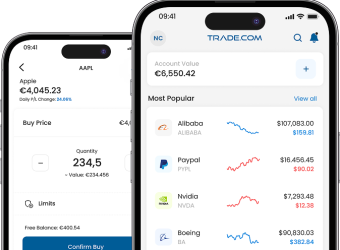Charges and Fees
Spreads
Discover Our Wide Range of CFD Asset Classes
Additional Fees
Definitions
A spread is the difference between the bid (sell) price and the ask (buy) price for a specific trade. It is therefore your cost of opening and closing a specific position and it could have a significant impact on the profitability of your trades.
Tighter spreads tend to mean lower trading costs, everything being equal. A tighter spread means that the market price doesn’t have to move as far from your entry price, for your trade to become profitable.
Volatility caused by major economic developments and market news can trigger sudden high fluctuations in the price of specific instruments, which can lead to an increase (or widening) of spreads, in order to cover the increased risk of volatile markets.
During daily breaks and in major news, spreads may widen.
Margin: can be thought of as a deposit that is required when using leverage. Each time you open a leveraged position a certain amount of your account balance is secured as margin. The exact amount is dependent on the size of the position and the leverage which is being used. Margin is there to guarantee the position you have opened in case it goes against you.
PIP stands for Percentage in Point and it is a standardized unit and is the smallest amount by which a currency quote can change. It is usually $0.0001 for U.S.-dollar related currency pairs, which is more commonly referred to as 1/100th of 1%, or one basis point.
Leverage involves borrowing a certain amount of the money needed to invest in something. In the case of forex, that money is usually accommodated by a broker. Leverage allows investors to command a much larger investment than their capital will allow, thus allowing them to potentially increase their returns while only investing a percentage of the overall value of the asset in question.
Leverage is estimated and depends on the real-time value of the instrument.
An overnight charge or sometimes called a swap fee is charged when you keep a position open overnight.
A rollover refers to the process of closing out open positions in soon-to- expire contracts in favor of contracts with later expiration dates.
Conversion fees apply when your account currency is different than the quoted currency of the underlying asset being traded. The fee will be reflected as a percentage of the conversion rate used.
Conversion Fees are as follows:
Profit/Loss: 2%
Overnight Rollover (Swaps) : 2%
CFD Rollover: 2%
Dividend Conversion Fee: 2%
Split Conversion Fee: 2%
We charge a $50 monthly fee, if no trading activity has occurred for 90 days or more.
A Deposit /Withdrawal Fee is a fee charged by the Company when depositing or withdrawing funds to and from your account. Currently you will not be charged any Deposit / Withdrawal Fees, as they are all covered by Trade.com. However we reserve the right to introduce minimum Deposit / Withdrawal Fees upon prior notification to our clients regarding the conditions and amounts of applying such fees.
Examples
Position Direction = Long (Buy)
Webtrader Volume = 12,600 ( MT4 = 1.26 lots)
MT4 Contract Size for Sugar = 10,000 lbs
MT4 Volume= Lots * Contract Size = 1.26 * 10,000 = 12,600 lbs
Sugar’s Spread = 0.04 USD
Sugar’s Mid Closing Price of the Day = 11.61 USD/lbs
Sugar’s Overnight Swap Charge = -0.0217 % = – 0.000217
Daily Swap Charge = 12,600 * 11.61 * (- 0.000217) = – 31,74 USD
12,600 * 0.79 = 9,954 USD
Since you have a buy position and the price difference is positive, the USD 9,954 will be charged to your account to compensate the corresponding floating P&L increase on your open position. (If, for the same example, you have a sell position, the USD 9,954 would have been credited to your account as a compensation for negative P&L)
Rollover Spread Charge = 12,600 * 0.04 = 504 USD
The spread charge is always charged on your account regardless of the type of position (buy or sell).
If your account currency is different from the instrument currency, then the amount is converted to your account currency at current market price.
Frequently Asked Questions
Total Rollover Adjustment = Rollover adjustment + Rollover spread charge.
Your accounts value, it equals your balance, plus any P&L from open positions.
Your accounts value excluding P&L from open positions – it equals the funds you deposited into your account and your P&L from closed positions.
You can see the trading hours of each instrument under the respective asset class on the homepage.
The sum of funds you have available to use as initial margin for new positions. Calculated by subtracting the margin used by your current open positions from your equity.
Indicates the sum of the margin currently being used by your open positions. Calculated by all of the initial margins of your open positions.
